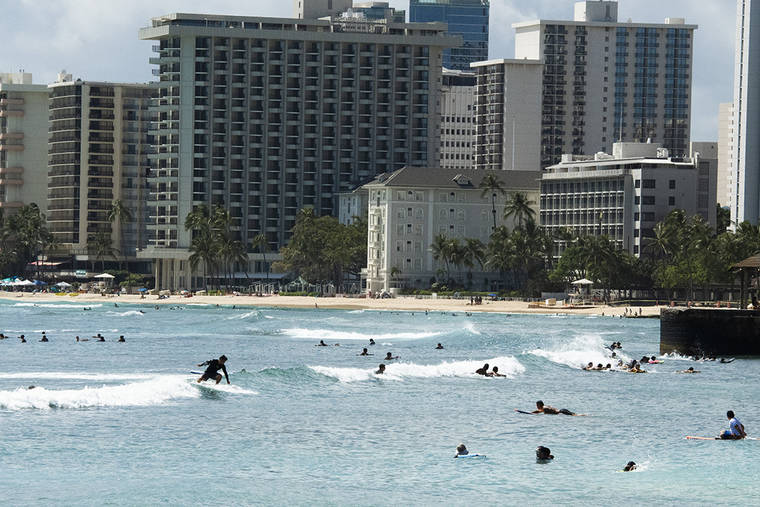Aloha United Way gives dire report on Hawaii poverty line amid coronavirus pandemic


CRAIG T. KOJIMA / CKOJIMA@STARADVERTISER.COM
A view of the Kapahulu groin in the popular Waikiki surfing area on June 12.


Aloha United Way released a financial hardship report today and the results — compiled even before the COVID-19 crisis ravaged Hawaii’s economy — are not pretty.
The 2020 AUW ALICE Report indicates no improvement over the last decade in the number of working residents who sit above the poverty line but are are unable to keep up with the cost of living.
In fact, the number of households in this group, known as ALICE, an acronym for Asset Limited, Income Constrained, Employed, grew only larger, according to the report, despite record unemployment lows, GDP growth and a slight rise in wages over the past two years.
Adding in those whose incomes are below the poverty line, the report estimated that 42% of Hawaii’s 455,138 households struggle to make ends meet.
But if that’s not bad enough, the report estimates that an additional 35,000 or more additional households — or 105,000 people — will end up struggling as members of this economic class by the end of 2020 due to the fallout from the coronavirus pandemic.
Lisa Kimura, AUW vice president of community impact, said the report was scheduled to come out in March but officials realized the economy was about to grow much worse.
Don't miss out on what's happening!
Stay in touch with breaking news, as it happens, conveniently in your email inbox. It's FREE!
The release happens now, in part, because the vulnerabilities identified in the report align with the economic disparities caused by the COVID-19 pandemic.
“Everything we identified as a vulnerability, including the lack of economic diversification, the heavy dependence on tourism, the low wages and the dependence on imports, came to fruition. It was prophetic,” Kimura said.
Aloha United Way officials said they offer the report as the backstory for why the COVID-19 crisis is having such a huge economic impact, and they hope it will help Hawaii leaders identify those most vulnerable and assist them throughout the pandemic and the recovery that follows.
When the pandemic struck in March, calls to the organization’s 211 helpline immediately shot up, and they are now coming in at a pace of 600% over what the helpline received before the crisis.
The top three requests for assistance are housing/shelter, healthcare and employment/income, which match the trends identified in the ALICE Report.
Those trends, identified from an analysis of data representing a point-in-time snapshot of economic conditions across the state in 2018, were:
>> The cost of household essentials — housing, child care, food, transportation, health care, phone and taxes — was rising faster than the cost of other goods and services.
>> Stagnant wages and little meaningful job growth. The only growth was concentrated in low-wage jobs with no growth in mid- and high-wage jobs that pay a living wage.
>> The number of ALICE households was increasing. While the number of households in poverty remained relatively flat from 2007 to 2018, ALICE households increased due to rising costs and stagnant wages.
Now, in hopes of guiding the state’s recovery plan, the AUW partnered with Hawaii Data Collaborative to estimate the potential impact of the pandemic over time.
According to modeling estimates, the percent of ALICE-and-below households could soar to 59% from 42% pre-COVID-19 without intervention to buffer the effects of the measures aimed at halting the spread of COVID-19. The 59% represents an additional 78,000 vulnerable households on top of the 190,390 that were already struggling.
State unemployment benefits and federal relief funds are keeping many of these households above water for now, officials said. But as the “new normal” COVID-19 economy stabilizes by the end of 2020, Hawaii could see 35,000 or more additional households in ALICE or below, according to the estimates.
The Hawaii Data Collaborative has also estimated that nearly 134,000 of all Hawaii households — about 30% — stand to lose a quarter or more of their income due to the effects of the pandemic on the local economy.



